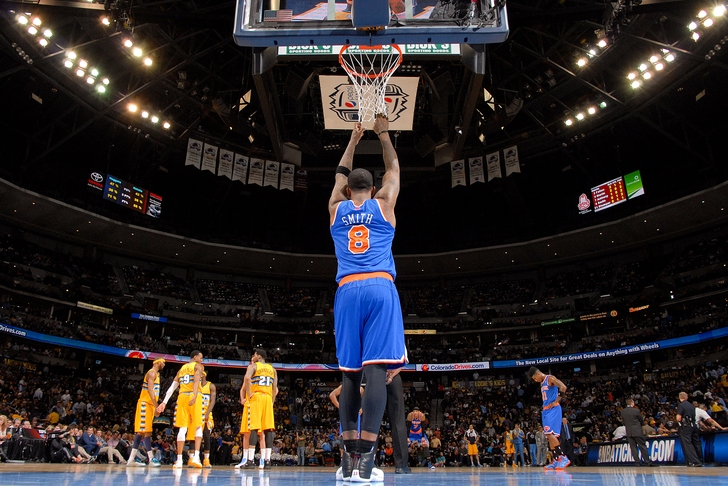If the Knicks want to find consistency and offensive production, J.R. Smith should be playing point guard. Hear me out on this one - for a team that had three point guards projected to play significant minutes this season, it may sound odd that the ticket to stability is to put the ball in the hands of a shoot-first loose cannon. The Knicks have exhausted their options, though, and need to start thinking outside of the box to get the most out of an injury-ravaged roster begging for help at the guard position.
J.R. Smith, one of the more troubling and disappointing Knicks on the roster, needs to be handling the ball more often if this team wants to reinvigorate their stagnant offense. This isn’t to suggest that Smith starts the game and doesn’t imply that he’s the lone point guard on the floor, but following his lead in the half-court offense could pay dividends for the Knicks’ offense.
The thought process, on the surface, seems completely counterintuitive. Smith has never been a creator, and he isn't the best at moving the ball around. Knicks fans have become well accustomed to a late-in-the-shot-clock crossover, a stepback, and then an ill-advised deep jumper by Smith. That’s who Smith has become – he fails to drive to the rim with any regularity, and the rest of his game is suffering as a result
The question is, how do you limit the bad J.R.? Keeping him focused is vital, as improvement in his play could massively strengthen New York’s playoff push. If the Knicks make him defer responsibility and keep him on the bench, it’ll do more harm than good, especially in the locker room. The solution? Put more trust in the enigmatic shooting guard. Placing the ball in his hands more in the half court set allows for him to have a well-defined role and a better idea of what he has to do.
Smith’s role would be to set the offense and run pick and rolls with the big men, swinging the ball around the perimeter and throwing entry passes into Carmelo Anthony when he’s posting up. This isn’t something new for Smith, who’s already done quite a bit of this in certain games throughout the season. Smith has had several games with over five assists, and despite his reputation, he’s a capable passer.
The goal of having Smith control the ball more is for him to utilize the pick and roll with the second unit, primarily running them with Amar’e Stoudemire and/or Andrea Bargnani. Smith showed signs of excelling in the half-court offense using pocket passes and side pick-and-rolls, even motivating Bargnani to commit toward breaking toward the basket in the pick and roll.
Smith’s athleticism allows for him to penetrate the lane with ease, but he’s taking a career-low 1.6 free throws per game. Whether he’s reluctant to trust his surgically repaired knee or disinterested in taking the ball to the rack, that just isn’t good enough. His percentage in the restricted area has dipped from 52.3 percent last season to 43 percent this season. Chris Herring of the Wall Street Journal pointed out that Iman Shumpert had a similar decline in his percentage when he returned from his ACL surgery last season, and that Smith recently complained about soreness in his leg.
That may not tell the whole story, though. The trouble could be the sample size and the inconsistent role that Smith has been asked to play this season - he took 333 shots in the restricted area last year, but has shot only 79 times in 34 games this season. If you extrapolate that over the entirety of a season you get around 190 shots, which is nearly 150 fewer than he took last season.
Blaming the low shooting percentage on Smith’s injury is too simplistic an answer. Getting to the free throw line and getting good looks at the basket has not only been a problem for Smith this season, but for the Knicks as a whole. The team has become overly reliant on jump shots, which has caused the inconsistent production that Knicks fans have become tortured by.
That offensive philosophy has been driven by the personnel that the Knicks are stuck with, but they don’t have to be content with it. Adapting and understanding that a guard-heavy lineup can help space the floor and avoid the congestion in the middle of the lane could be a huge boon to the team’s offense, especially with the team making two fewer 3-pointers a game than they did last season.
In order to do that, the team would be wise to place more trust in Smith. Kirk Goldsberry of Grantland recently wrote about Rudy Gay—a player bashed for his inefficiency for the past few years—as being a player that had to have his usage properly balanced in order to be maximized efficiently. Smith’s usage rate is at a career low 20.5 percent, which has led to the lowest efficiency rate of his career (10.7). Last season, arguably the best of Smith’s career, he had his second-highest usage and efficiency rating of his career.
His shenanigans on and off the court could drive the most patient of coaches crazy, which is why he’s been given such a short leash recently. The Knicks have a ton of defensive problems and seem to have another distraction in Beno Udrih, but they could alleviate some of their issues on the offensive side of the ball if they show some trust in their biggest underperformer of the season.
Back to the New York Knicks Newsfeed
